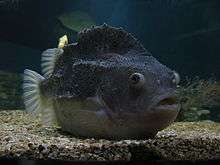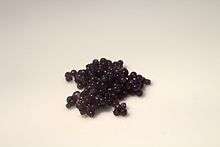Cyclopterus lumpus
| Lumpsucker or lumpfish Cyclopterus lumpus | |
|---|---|
 | |
| Adult at the Dorée Tropical Aquarium | |
.jpg) | |
| Juvenile | |
| Scientific classification | |
| Kingdom: | Animalia |
| Phylum: | Chordata |
| Class: | Actinopterygii |
| Order: | Scorpaeniformes |
| Family: | Cyclopteridae |
| Genus: | Cyclopterus Linnaeus, 1758 |
| Species: | C. lumpus |
| Binomial name | |
| Cyclopterus lumpus Linnaeus, 1758 | |
Cyclopterus lumpus, the lumpsucker or lumpfish, is a species of marine fish in the family Cyclopteridae (lumpsuckers). It is the only member of the genus Cyclopterus.[1] It is found in the North Atlantic and adjacent parts of the Arctic Ocean, ranging as far south as Chesapeake Bay (rare south of New Jersey) on the North American coast and Spain on the European coast.[2]
Description
Males typically reach 30–40 cm (12–16 in) in length and the larger females rarely surpass 50 cm (20 in) in length and 5 kg (11 lb) in weight.[3] The maximum is 61 cm (24 in) in length and 9.5 kg (21 lb) in weight.[2] In the brackish water of the Baltic Sea it usually does not surpass 20 cm (8 in).[3] The body is ball-like. It has a knobbly, ridged back and three large bony tubercles on each flank. Its pelvic fins form suction discs which it uses to attach strongly to rocks or other surfaces. The head and the pectoral fins of males are larger than those of females. It has a jelly-like layer of fat under the skin which makes it appear to quiver when held in the hand.[4] Its colour is highly variable; bluish, greyish, olive, yellowish or brownish.[5] Mature males, which turn orange-reddish during the breeding season, are brighter than females.[5]
Biology
After hatching, lumpfish will spend their first few months in tidal pools,[6] or in association with floating seaweed clumps.[7] As they grow they migrate out into open water far from land where they live in the pelagic zone[8] feeding upon gelatinous zooplankton, fish eggs and small crustaceans.[9] When they reach maturity they will migrate to coastal areas in spring to breed. The female can carry 100,000–350,000 eggs, which are laid in a "nest" that is made in relatively shallow water by the male.[3] The male also guards and cares for the eggs by fanning them with his fins during the month-long incubation period.[5]
Several aspects of their biology (i.e. lack of a swimbladder, its pelvic suction disc) led some to believe that they were a bottom dwelling species.[10] Lumpfish are frequently caught in pelagic fishing nets,[8][11] however, capture in bottom trawls is also common.[12][13] An investigation using electronic data-storage tags attached to the fish have confirmed that, at least during its breeding migration, this fish will spend time associated with the sea bed, and also some time in the pelagic zone.[14] As the fish came close to breeding, they began to spend a greater amount of time in the pelagic zone. With the lack of a swim bladder, the fish were able to make rapid movements through the water column, moving between surface waters and depths of over 300 m (980 ft) within one day. Data from research surveys and data-storage tags show that adult lumpfish alter their behaviour between night and day with the fish spending more time in the pelagic zone at night and found associated with the seabed during the day, the reasons for this are unclear.[12][14] This fish is now considered to be a semi-pelagic/semi-demersal fish.
Fishery
Fisheries in Iceland and Greenland are the main contributors to the worldwide catch of lumpfish.[15] Historically, Norway and Canada also contributed significant amounts but due to a decrease in the price of salted roe, and a severe population decline in Canada,[16] the contribution from these countries has decreased. Denmark and Sweden have also contributed but the amount has been low in comparison with the other countries.[15] Female fish are the main target for the fishery which utilizes the roe to make lumpfish caviar.[15] Lumpfish are targeted close to the shore, where they come to spawn, using small fishing boats (generally less than 15 m or 49 ft) with large mesh gillnets.[15] Due to the smaller size of the male, very few are caught in the large meshes. Traditionally, the roe would be removed at sea and the bodies disposed of. In Iceland, it is now mandatory for the bodies to be landed;[17] these are now frozen and exported, mainly to China.
In Iceland, there is also the tradition of catching the male fish, mainly for the local market. This is done using gillnets with a smaller mesh size than that used for the females. The males are targeted in January–February, which is earlier than the females which are targeted from March until August.
Uses

The roe of the fish, a good source of omega-3 fatty acids, is used to produce relatively inexpensive imitation "caviar", with the eggs dyed either red or black, pasteurised then packed with a mould-inhibitor such as sodium benzoate (E211).[18] In Scandinavia the flesh of the fish is eaten.[2]
References
- ↑ Froese, Rainer, and Daniel Pauly, eds. (2012). Species of Cyclopterus in FishBase. July 2012 version.
- 1 2 3 Froese, Rainer and Pauly, Daniel, eds. (2012). "Cyclopterus lumpus" in FishBase. July 2012 version.
- 1 2 3 Muus, B., J. G. Nielsen, P. Dahlstrom and B. Nystrom (1999). Sea Fish. pp. 180–181. ISBN 8790787005
- ↑ "Lumpfish: Cyclopterus lumpus". NatureGate. Retrieved 2013-12-16.
- 1 2 3 Kells, V., and K. Carpenter (2011). A Field Guide to the Coastal Fishes from Maine to Texas. pp. 192–193. ISBN 978-0-8018-9838-9
- ↑ Mocheck, A. D. (1973). "Spawning behaviour of the lumpsucker Cyclopterus lumpus L.". Journal of Ichthyology (13): 615–619.
- ↑ Ingólfsson, Agnar (2000-12-01). "Colonization of floating seaweed by pelagic and subtidal benthic animals in southwestern Iceland". Hydrobiologia. 440 (1–3): 181–189. doi:10.1023/A:1004119126869. ISSN 0018-8158.
- 1 2 Holst, Jens Christian (1993-08-01). "Observations on the distribution of lumpsucker (Cyclopterus lumpus, L.) in the Norwegian Sea". Fisheries Research. 17 (3–4): 369–372. doi:10.1016/0165-7836(93)90136-U.
- ↑ Davenport, J. (1985). "Synopsis of biological data on the lumpsucker Cyclopterus lumpus (Linnaeus, 1758)". FAO Fisheries Synopsis (147).
- ↑ Wheeler, A. (1969). The fishes of the British Isles and north-west Europe. London: Macmillan. ISBN 0333059557.
- ↑ Eriksen, Elena; Durif, Caroline M. F.; Prozorkevich, Dmitry (2014-11-01). "Lumpfish (Cyclopterus lumpus) in the Barents Sea: development of biomass and abundance indices, and spatial distribution". ICES Journal of Marine Science. 71 (9): 2398–2402. doi:10.1093/icesjms/fsu059. ISSN 1054-3139.
- 1 2 Casey, Jill M; Myers, Ransom A (1998-10-01). "Diel variation in trawl catchability: is it as clear as day and night?". Canadian Journal of Fisheries and Aquatic Sciences. 55 (10): 2329–2340. doi:10.1139/f98-120. ISSN 0706-652X.
- ↑ Wienerroither, R. (2011). "Atlas of the Barents Sea fishes". IMR/PINRO Joint Report.
- 1 2 Kennedy, James; Jónsson, Sigurður Þ.; Ólafsson, Halldór G.; Kasper, Jacob M. (2015-12-23). "Observations of vertical movements and depth distribution of migrating female lumpfish (Cyclopterus lumpus) in Iceland from data storage tags and trawl surveys". ICES Journal of Marine Science: fsv244. doi:10.1093/icesjms/fsv244. ISSN 1054-3139.
- 1 2 3 4 Johannesson, J. (2006). "Lumpfish cavier - from vessel to consumer". FAO Fisheries Technical Paper. 485.
- ↑ DFO (2011). "Assessment of Lumpfish in the Gulf of St. Lawrence (3Pn, 4RST) in 2010". DFO Can. Sci. Advis. Sec., Sci., Advis. Rep. 2011/005.
- ↑ Marine Stewardship Council (2014). "Icelandic Gillnet Lumpfish Fishery". Public Certification Report. Retrieved 2 March 2016.
- ↑ Hui, Yiu H. (2006). Handbook of Food Science, Technology, and Engineering. CRC Press. pp. 161–9. ISBN 978-0-8493-9849-0.
| Wikimedia Commons has media related to Cyclopterus lumpus. |